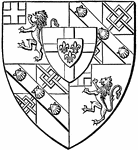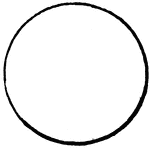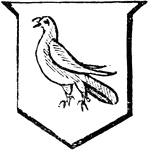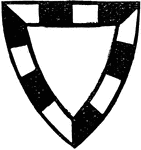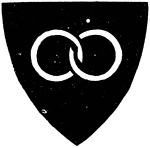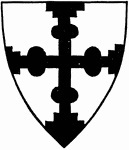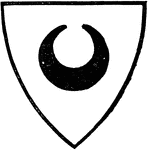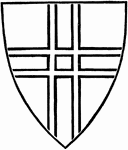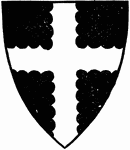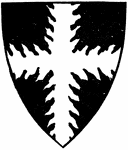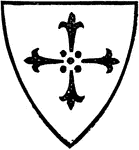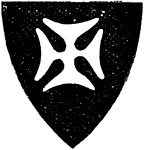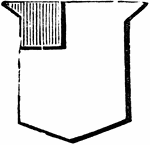
Canton
"CANTON. The French word for corner. It is a small square figure, generally placed at the dexter chief…
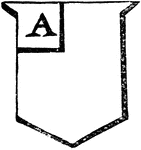
Canton Ordinary
"The canton is a square part of the escutcheon, usually occupying about one-eighth of the field; it…

Chaplet
"Argent, a chaplet proper. CHAPLET. An ancient ornament for the head, granted to gallant knights for…
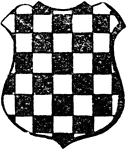
Checky
"Checky, sable and argent. CHECKY. The field covered with alternate squares of metal and fur." -Hall,…
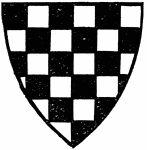
Chequée
"Chequée is when the field is divided by lines perpendicular and horizontal, crossing each other,…
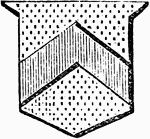
Chevron
"Or, a chevron gules. CHEVRON. This ordinary is supposed to represent the rafters of the gable of a…

Shield Showing Chevron
Argent, two chevronels, gules. The diminutives of the chevron, according to English Heraldry, are the…

Chevronels
"Argent, two chevronels gules. CHEVRONEL. The diminutive of the chevron, being one half its size." -Hall,…

Shield Showing Chevronels
Gules, three couple-closes interlaced in base, or ... the couple-close ... is half the chevronel. -Hall,…
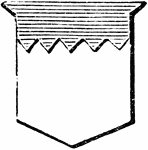
Chief Indented
"Argent, a chief, azure, indented. The chief is an ordinary terminated by an horizontal line, which,…
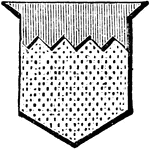
Chief Indented
"Or, a chief gules, indented. INDENTED. A serrated figure, much smaller than the dancette." -Hall, 1862
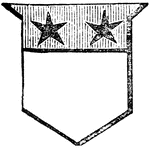
Chief Ordinary
"Argent, on a chief, gules, two mullets, sable. The chief is an ordinary terminated by an horizontal…
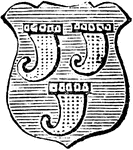
Clarion
"Azure, three clarions or. CLARION. A horn or trumpet borne in this shape in English and German coat-armour."…
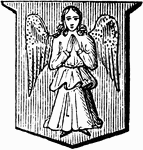
Closegirt
"Gules, an angel erect with wings expanded or, dress closegirt. CLOSEGIRT. A figure whose dress is fastened…
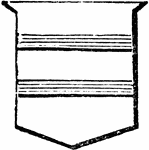
Shield Showing Closet
Gules, two barrulets, argent. The barrulet is half the width of the closet. -Hall, 1862
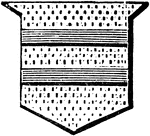
Closets
"Or, two closets azure. CLOSET. A diminutive of the bar, being only one half its width." -Hall, 1862

Compony
"Argent, an inescutcheon azure, border compony, or and gules. COMPONY. A term applied to a bordure,…

Cotice
"Gules, a bend argent, coticed of the same. COTICE. One of the diminutives of the bend: cotices are…

Shield Showing Cotice
Argent, a riband vert. The riband, which is one third less than the garter and the bendlet, must never…

Counter-Componée
"Counter-componée has two rows of squares, with a metal and color alternating."—Aveling,…
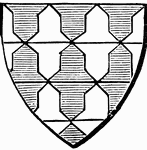
Counter-Vair Shield
"Counter-vair is when the arrangement of the little shields or bells is varied so that those of the…
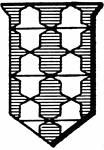
Counter-Vair Shield Fur
A shield or escutcheon emblazoned with the fur, vair, represented by alternating azure (blue) and argent…

Couple-Close
Or, a cross, gules. THE CROSS ... as its name imports, was the distinguishing badge of the Crusaders,…

Couple-Close
"Argent, three couple-closes interlaced vert. COUPLE-CLOSE. One of the diminutives of the chevron, half…

Crescent
"Azure, a crescent argent. CRESCENT. The half moon with its horns turned upwards." -Hall, 1862
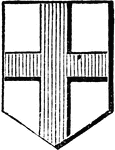
Cross
"CROSS. An honourable ordinary, more used as a charge in a coat of arms than any of the others." -Hall,…

Cross Bottonny
"Cross bottonny. CROSS. An honourable ordinary, more used as a charge in a coat of arms than any of…

Cross Couped
"Azure, a cross couped argent. COUPED. From the French word couper, to cut. The cross in the example…

Cross Crosslet
"Cross crosslet. CROSS. An honourable ordinary, more used as a charge in a coat of arms than any of…
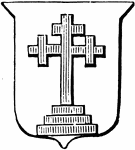
Cross Crosslet on Grieces
"Cross Crosslet on Grieces. GRIECE. In heraldry, a degree or step, as one of the steps upon which crosses…
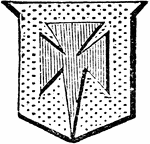
Cross Fitchy
"Cross fitchy. CROSS. An honourable ordinary, more used as a charge in a coat of arms than any of the…
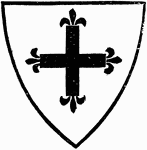
Cross Fleur-De-Lis
A heraldic shield with a charge cross in which the extremities terminate with fleurs-de-lis.
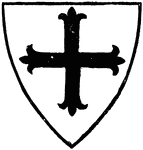
Cross Fleury
"A Cross Fleury, or Fleurie, is borne in the arms of Lord Brougham and Vaux. It is not very unlike the…
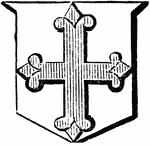
Cross Flory
"Cross flory. CROSS. An honourable ordinary, more used as a charge in a coat of arms than any of the…
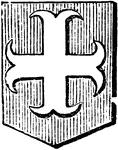
Cross Moline
"Cross moline. CROSS. An honourable ordinary, more used as a charge in a coat of arms than any of the…

Cross of Calvary
"Cross of Calvary. CROSS. An honourable ordinary, more used as a charge in a coat of arms than any of…

Cross Ordinary
Gules, a saltier, argent. The saltier was formed by making two pieces of riband cross diagonally, having…
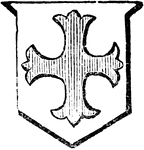
Cross Patonce
"Cross patonce. CROSS. An honourable ordinary, more used as a charge in a coat of arms than any of the…
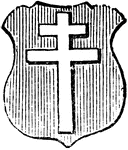
Cross Patriarchal
"Cross patriarchal. CROSS. An honourable ordinary, more used as a charge in a coat of arms than any…
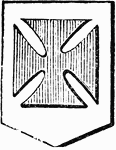
Cross Pattee
"Cross pattee. CROSS. An honourable ordinary, more used as a charge in a coat of arms than any of the…
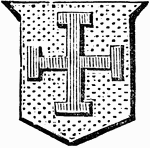
Cross Potent
"Cross potent. CROSS. An honourable ordinary, more used as a charge in a coat of arms than any of the…
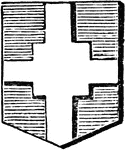
Cross Quadrate
"Cross quadrate. CROSS. An honourable ordinary, more used as a charge in a coat of arms than any of…
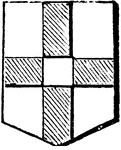
Cross Quarter-Pierced
"Cross quarter-pierced. CROSS. An honourable ordinary, more used as a charge in a coat of arms than…

Cross Quarterly
"Cross Quarterly is a Cross cut by a partition line, and the tinctures reversed or counter-changed."—Aveling,…
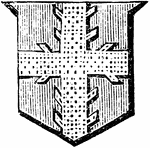
Cross Raguly
"Cross raguly. CROSS. An honourable ordinary, more used as a charge in a coat of arms than any of the…

Cross Recercelée
"The Cross Recercelée is very similar to the Cross Moline, but the extremities are curled backwards."—Aveling,…
